英美概况-希腊罗马神话教案
- 格式:doc
- 大小:282.50 KB
- 文档页数:8
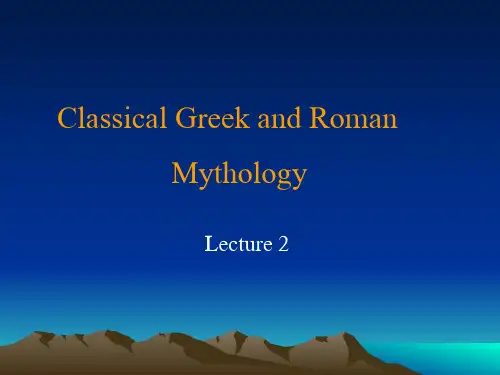
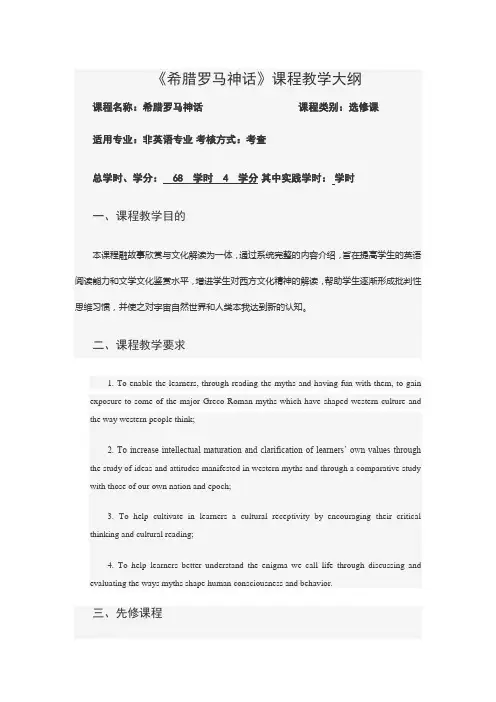
《希腊罗马神话》课程教学大纲课程名称:希腊罗马神话课程类别:选修课适用专业:非英语专业考核方式:考查总学时、学分:68学时4学分其中实践学时:学时一、课程教学目的本课程融故事欣赏与文化解读为一体,通过系统完整的内容介绍,旨在提高学生的英语阅读能力和文学文化鉴赏水平,增进学生对西方文化精神的解读,帮助学生逐渐形成批判性思维习惯,并使之对宇宙自然世界和人类本我达到新的认知。
二、课程教学要求1. To enable the learners, through reading the myths and having fun with them, to gainexposure to some of the major Greco-Roman myths which have shaped western culture and the way western people think;2. To increase intellectual maturation and clarification of learners’ own values throughthe study of ideas and attitudes manifested in western myths and through a comparative study with those of our own nation and epoch;3. To help cultivate in learners a cultural receptivity by encouraging their criticalthinking and cultural reading;4. To help learners better understand the enigma we call life through discussing andevaluating the ways myths shape human consciousness and behavior.三、先修课程大学英语三四册四、课程教学重、难点重点介绍神话的定义和主要阅读方法,以及希腊罗马生简史,旨在帮助学生建立正确的神话观,激发学生学习的兴趣和积极性。
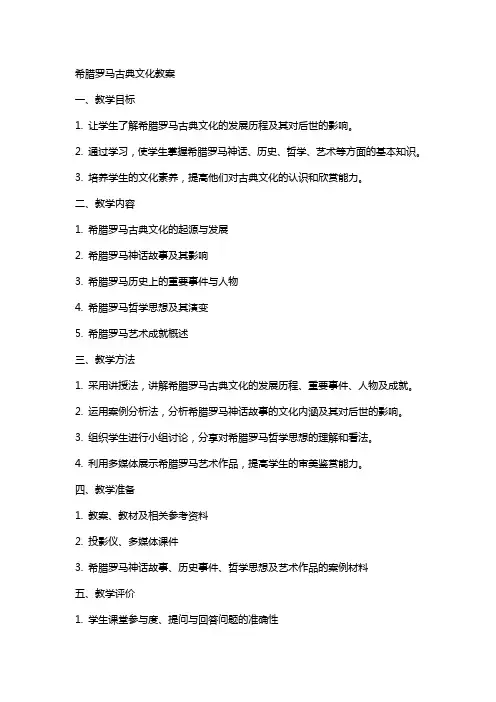
希腊罗马古典文化教案一、教学目标1. 让学生了解希腊罗马古典文化的发展历程及其对后世的影响。
2. 通过学习,使学生掌握希腊罗马神话、历史、哲学、艺术等方面的基本知识。
3. 培养学生的文化素养,提高他们对古典文化的认识和欣赏能力。
二、教学内容1. 希腊罗马古典文化的起源与发展2. 希腊罗马神话故事及其影响3. 希腊罗马历史上的重要事件与人物4. 希腊罗马哲学思想及其演变5. 希腊罗马艺术成就概述三、教学方法1. 采用讲授法,讲解希腊罗马古典文化的发展历程、重要事件、人物及成就。
2. 运用案例分析法,分析希腊罗马神话故事的文化内涵及其对后世的影响。
3. 组织学生进行小组讨论,分享对希腊罗马哲学思想的理解和看法。
4. 利用多媒体展示希腊罗马艺术作品,提高学生的审美鉴赏能力。
四、教学准备1. 教案、教材及相关参考资料2. 投影仪、多媒体课件3. 希腊罗马神话故事、历史事件、哲学思想及艺术作品的案例材料五、教学评价1. 学生课堂参与度、提问与回答问题的准确性2. 学生作业、小测验的成绩3. 学生对希腊罗马古典文化的认识和欣赏能力的提高情况4. 学生对课堂内容的满意度及建议六、教学安排1. 课时:本教案共需15课时,每课时45分钟。
2. 教学进度安排:第1-4课时:希腊罗马古典文化的起源与发展第5-8课时:希腊罗马神话故事及其影响第9-12课时:希腊罗马历史上的重要事件与人物第13-14课时:希腊罗马哲学思想及其演变第15课时:希腊罗马艺术成就概述七、教学重点与难点1. 教学重点:希腊罗马古典文化的发展历程及其对后世的影响。
希腊罗马神话故事的主要内容及其文化内涵。
希腊罗马历史上的重要事件与人物。
希腊罗马哲学思想的主要流派及其代表人物。
希腊罗马艺术的主要成就及其特点。
2. 教学难点:希腊罗马神话故事中的人物关系和故事脉络。
希腊罗马哲学思想的深层含义及其对现代社会的启示。
希腊罗马艺术作品的风格特点及其历史背景。
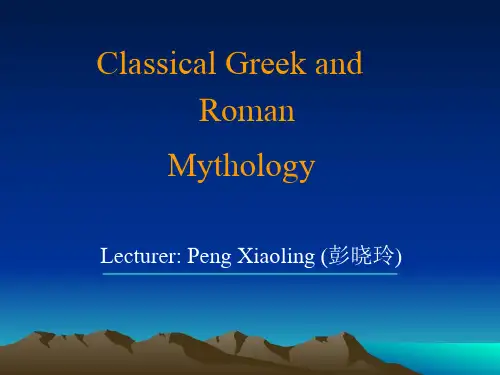
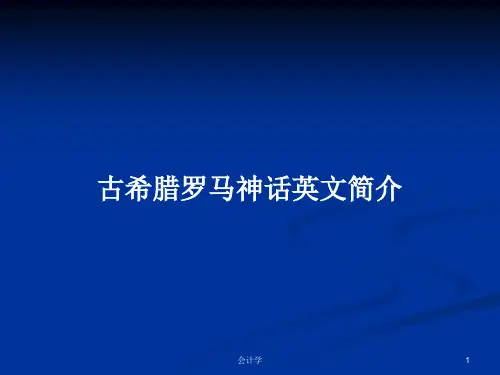
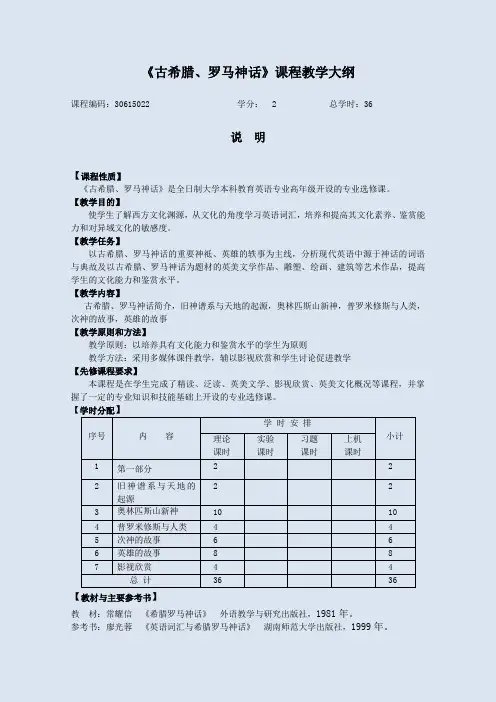
《古希腊、罗马神话》课程教学大纲课程编码:30615022 学分: 2 总学时:36说明【课程性质】《古希腊、罗马神话》是全日制大学本科教育英语专业高年级开设的专业选修课。
【教学目的】使学生了解西方文化渊源,从文化的角度学习英语词汇,培养和提高其文化素养、鉴赏能力和对异域文化的敏感度。
【教学任务】以古希腊、罗马神话的重要神祗、英雄的轶事为主线,分析现代英语中源于神话的词语与典故及以古希腊、罗马神话为题材的英美文学作品、雕塑、绘画、建筑等艺术作品,提高学生的文化能力和鉴赏水平。
【教学内容】古希腊、罗马神话简介,旧神谱系与天地的起源,奥林匹斯山新神,普罗米修斯与人类,次神的故事,英雄的故事【教学原则和方法】教学原则:以培养具有文化能力和鉴赏水平的学生为原则教学方法:采用多媒体课件教学,辅以影视欣赏和学生讨论促进教学【先修课程要求】本课程是在学生完成了精读、泛读、英美文学、影视欣赏、英美文化概况等课程,并掌握了一定的专业知识和技能基础上开设的专业选修课。
【学时分配】序号内容学时安排小计理论课时实验课时习题课时上机课时1 第一部分2 22 旧神谱系与天地的起源2 23 奥林匹斯山新神10 104 普罗米修斯与人类 4 45 次神的故事6 66 英雄的故事8 87 影视欣赏 4 4总计 36 36 【教材与主要参考书】教材:常耀信《希腊罗马神话》外语教学与研究出版社,1981年。
参考书:廖光蓉《英语词汇与希腊罗马神话》湖南师范大学出版社,1999年。
徐国萍《希腊罗马神话及典故成语》海洋出版社,2001年。
陶洁《希腊罗马神话一百篇》中国对外翻译出版公司,1989年。
大纲内容第一部分古希腊、罗马神话简介【教学目的和要求】教学目的:了解希腊述神话的起源、形成、和发展教学要求:掌握学习古希腊、罗马神话的意义、目的,重要性和方法【内容提要】第一节什么是神话第二节神话的起源和发展第三节神话故事与神话学的区别第四节神话的分类第五节学习神话的原因、意义和方法【教学重点与难点问题】教学重点:神话的分类教学难点:神话的起源和发展【复习思考题】1. 什么是神话?2. 神话故事与神话学的区别是什么?第二部分天地的起源【教学目的和要求】教学目的:讲述天地的起源教学要求:掌握旧神谱系中主要的神及由此派生出来的英语词汇【内容提要】第一节天地的起源第二节旧神谱系:地神盖娅、天神乌拉诺斯,十二提坦巨神第三节以cosmos、chron为词根的派生单词【教学重点与难点问题】教学重点:天地如何起源的教学难点:旧神谱系中诸神之间的关系及名称【复习思考题】1.天地是如何起源的?2.试论述旧神谱系中诸神的关系。
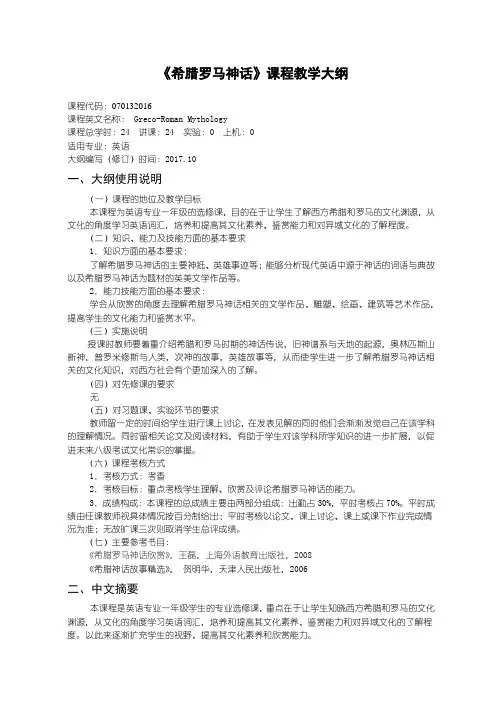
《希腊罗马神话》课程教学大纲课程代码:070132016课程英文名称: Greco-Roman Mythology课程总学时:24 讲课:24 实验:0 上机:0适用专业:英语大纲编写(修订)时间:2017.10一、大纲使用说明(一)课程的地位及教学目标本课程为英语专业一年级的选修课,目的在于让学生了解西方希腊和罗马的文化渊源,从文化的角度学习英语词汇,培养和提高其文化素养、鉴赏能力和对异域文化的了解程度。
(二)知识、能力及技能方面的基本要求1.知识方面的基本要求:了解希腊罗马神话的主要神抵、英雄事迹等;能够分析现代英语中源于神话的词语与典故以及希腊罗马神话为题材的英美文学作品等。
2.能力技能方面的基本要求:学会从欣赏的角度去理解希腊罗马神话相关的文学作品、雕塑、绘画、建筑等艺术作品,提高学生的文化能力和鉴赏水平。
(三)实施说明授课时教师要着重介绍希腊和罗马时期的神话传说,旧神谱系与天地的起源,奥林匹斯山新神,普罗米修斯与人类,次神的故事,英雄故事等,从而使学生进一步了解希腊罗马神话相关的文化知识,对西方社会有个更加深入的了解。
(四)对先修课的要求无(五)对习题课、实验环节的要求教师留一定的时间给学生进行课上讨论,在发表见解的同时他们会渐渐发觉自己在该学科的理解情况。
同时留相关论文及阅读材料,有助于学生对该学科所学知识的进一步扩展,以促进未来八级考试文化常识的掌握。
(六)课程考核方式1.考核方式:考查2.考核目标:重点考核学生理解、欣赏及评论希腊罗马神话的能力。
3.成绩构成:本课程的总成绩主要由两部分组成:出勤占30%,平时考核占70%。
平时成绩由任课教师视具体情况按百分制给出;平时考核以论文、课上讨论、课上或课下作业完成情况为准;无故旷课三次则取消学生总评成绩。
(七)主要参考书目:《希腊罗马神话欣赏》,王磊,上海外语教育出版社,2008《希腊神话故事精选》,贺明华,天津人民出版社,2006二、中文摘要本课程是英语专业一年级学生的专业选修课,重点在于让学生知晓西方希腊和罗马的文化渊源,从文化的角度学习英语词汇,培养和提高其文化素养、鉴赏能力和对异域文化的了解程度。
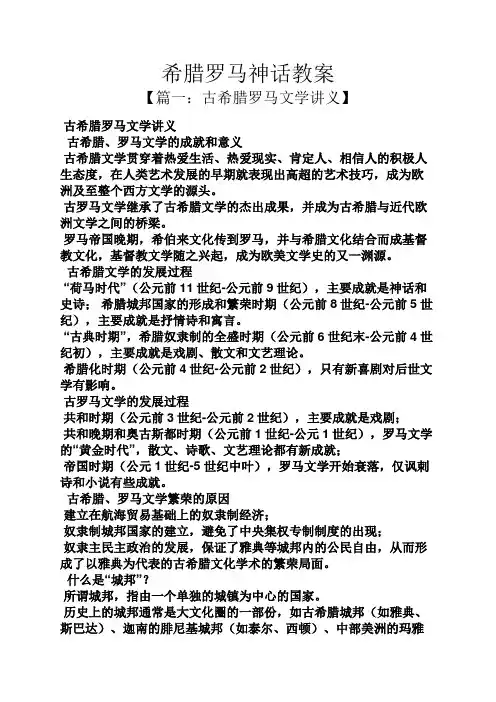
希腊罗马神话教案【篇一:古希腊罗马文学讲义】古希腊罗马文学讲义古希腊、罗马文学的成就和意义古希腊文学贯穿着热爱生活、热爱现实、肯定人、相信人的积极人生态度,在人类艺术发展的早期就表现出高超的艺术技巧,成为欧洲及至整个西方文学的源头。
古罗马文学继承了古希腊文学的杰出成果,并成为古希腊与近代欧洲文学之间的桥梁。
罗马帝国晚期,希伯来文化传到罗马,并与希腊文化结合而成基督教文化,基督教文学随之兴起,成为欧美文学史的又一渊源。
古希腊文学的发展过程“荷马时代”(公元前11世纪-公元前9世纪),主要成就是神话和史诗;希腊城邦国家的形成和繁荣时期(公元前8世纪-公元前5世纪),主要成就是抒情诗和寓言。
“古典时期”,希腊奴隶制的全盛时期(公元前6世纪末-公元前4世纪初),主要成就是戏剧、散文和文艺理论。
希腊化时期(公元前4世纪-公元前2世纪),只有新喜剧对后世文学有影响。
古罗马文学的发展过程共和时期(公元前3世纪-公元前2世纪),主要成就是戏剧;共和晚期和奥古斯都时期(公元前1世纪-公元1世纪),罗马文学的“黄金时代”,散文、诗歌、文艺理论都有新成就;帝国时期(公元1世纪-5世纪中叶),罗马文学开始衰落,仅讽刺诗和小说有些成就。
古希腊、罗马文学繁荣的原因建立在航海贸易基础上的奴隶制经济;奴隶制城邦国家的建立,避免了中央集权专制制度的出现;奴隶主民主政治的发展,保证了雅典等城邦内的公民自由,从而形成了以雅典为代表的古希腊文化学术的繁荣局面。
什么是“城邦”?所谓城邦,指由一个单独的城镇为中心的国家。
历史上的城邦通常是大文化圈的一部份,如古希腊城邦(如雅典、斯巴达)、迦南的腓尼基城邦(如泰尔、西顿)、中部美洲的玛雅城邦、丝绸之路上的小国(如撒马尔罕、布哈拉)和意大利城邦(如佛罗伦斯、威尼斯)。
中国周代实行封建制度,分封的一些诸侯国有时也被称为城邦。
顾准:《希腊城邦制度——读希腊史笔》,贵州人民出版社1994年版。
“城邦”的制度形式贵族制:由贵族集体领导,权力受公民大会制约;寡头制:由少数贵族领导,权力受公民大会制约;僭主制:依靠武力或非法手段夺权,无视公民大会,但往往取悦于平民,有利于向民主制转变;君主制:君主终身世袭,独掌大权,但形式上保留公民大会;民主制:人民集体享有主权,公民大会是最高权力机关。
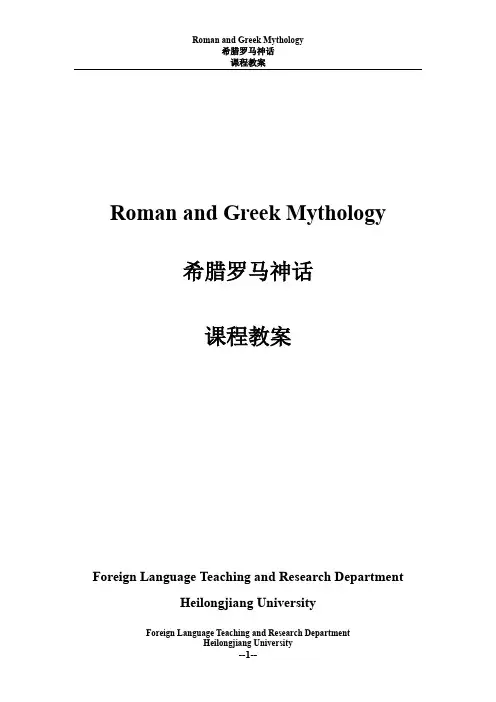
Roman and Greek Mythology希腊罗马神话课程教案Foreign Language Teaching and Research DepartmentHeilongjiang UniversityForeign Language Teaching and Research Department★ Introduction of GreeceI.ObjectivesStudents will be able to :1. get to know something about GreeceII.Lesson PlanGreece is the southeasternmost region on the European continent. It is defined by a series of mountains, surrounded on all sides except the north by water, and endowed with countless large and small islands. The Ionian (爱奥尼亚) and Aegean seas and the many deep bays and natural harbors along the coastlines allowed the Greeks to prosper in maritime commerce(海上贸易)and to develop a culture which drew inspiration from many sources, both foreign and indigenous. Greece has a history stretching back almost 4000 years. The people of the mainland, called Hellenes(古希腊人), organised great naval and military expeditions, and explored the Mediterranean and the Black Sea, going as far as the Atlantic Ocean and the Caucasus Mountains(高加索山脉). One of those expeditions, the siege of Troy, is narrated in the first great European literary work, Homer's Iliad. During the Classical period (5th century B.C.), Greece was composed of city-states(古希腊的城邦), the largest being Athens, followed by Sparta(斯巴达)and Thebes(底比斯). In the second half of the 4th century B.C., the Greeks, led by Alexander the Great①, conquered most of the then known world and sought to Hellenize it. In 146 BC Greece fell to the Romans.During the Hellenistic period, the Greek world was reaching as far east as India. At length its culture became one of the oldest and the most resplendent ancient civilizations in history---Hellenic culture. From this moment on, I will do my best to present you the culture from mythology stories.Foreign Language Teaching and Research DepartmentChapter1 IntroductionI. ObjectivesStudents will be able to :1. get to know the Beginning of the World2. get to know the Olympian GodsII. Learning Difficultiesdifferent names of the gods and goddessesIII.Lesson Plan★ 1.1 The Beginning of the WorldBefore earth and sea and heavens became known, the face of nature was one crude, formless mass. Land and sea and air were mingled together. The universe was a uniform darkness, without sun, moon, let alone the earth. In the middle of the darkness sat Chaos and his wife---Nyx [niks], the goddess of Night, who reigned but did not rule. So the whole space was lifeless. Centuries later, with the birth of Light and Day, earth and sea and air came into being. And also Chaos and Nyx gave birth to Gaea 盖亚(Earth), and Gaea gave birth to Uranus (Heaven) and married him. Still later, the union of Gaea and Uranus gave birth to the Titans (The Titans of Greek mythology were the twelve children of Gaea and Uranus), the Cyclopes and the Centimani. Afraid that his own gigantic children might usurp his throne, Uranus drove them all back to the earth, and this roused the resentment of the mother Gaea. At her instigation one of her sons, Cronus (one Titan) attacked and wounded Uranus with a sickle given by Gaea. Thus Cronus got the crown and became the supreme ruler of the universe.He married his own sister Rhea and entrusted the management of the sun to his brother Hyperion and the moon to his sister Phoebe. Cronus ruled his realm peacefully until an oracle prophesied that he would one day be dethroned/overthrown by one of his own children. To avoid the disaster he took the excessive precaution of swallowing up all his five children one by one after their birth. These were Hesia The goddess of the hearth (赫斯提:女灶神) Demeter (The goddess of the harvest得墨忒耳:主管收获的女神), Hera, Poseidon (The god of the waters, earthquakes, and horses), Hades (The god of the netherworld). When Rhea bore the last child, Zeus (Jupiter), Cronus wanted to get rid of him in the same fashion. But the mother wrapped up a piece of stone in the infant’s swathes and handed it over to the unsuspecting father. Thus Zeus was saved and sent to Mt Ida (艾达峰:克里特岛中部一山峰), where the mountain nymphs (宁芙女神:以美丽女子形象出现,有时化身为树、水和山等自然之物的小女神) did all in their power to protect him from any harm. By the time Cronus became aware of the deception, it was too late, for young Zeus suddenly appeared before him and easily deposed/dethroned him.Foreign Language Teaching and Research DepartmentWith the help of a nauseous potion, Zeus forced his father to disgorge his five brothers and sisters. But Cronus and his Titans were not reconciled to their defeat. They made war on Zeus and his brothers and sisters. Acting on the advice of his mother Rhea, Zeus released the Cyclopes from under the earth and armed himself with their thunderbolts, for the Cyclopes were thunderbolt-makers. Soon Cronus and Titans were forced to submission and cast down into Tartarus (The regions below Hades where the Titans were confined塔尔塔罗斯:冥府下面的深渊). Thus Zeus became the ruler of the Olympus. He made his sister Hera his queen, and distributed power among his brothers and sisters and his sons and daughters. Among them, Poseidon ruled over the vast expanse of seas and oceans, and Pluto was assigned as the lord to the lower world.★ 1.2 The Olympian GodsOn Mt Olympus, the overlord of gods---Zeus---was not an autocrat; he led a council of twelve members (i.e. there were twelve major gods on Mt Olympus).There were twelve Olympians, although you may run across fourteen different names. Hestia, Demeter, Dionysus, and Hades are variable. The remaining ten are: Apollo, Ares, Hermes, Hephaestus, Poseidon, and Zeus, among the gods; Aphrodite, Athena, Artemis, and Hera, among the goddesses.Zeus(宙斯天王): Zeus is the ruler of the Olympian gods. He is also known as Jupiter in Roman. His attributes in iconography include the lightning bolt, the eagle, and the scepter. Hera(赫拉天后婚姻神): As the wife (and sister) of Zeus, Hera is the patron of marriage. She is also known as Juno (Roman). She has no unique attributes in iconography and so can only be identified by context or inscription.Poseidon(波塞冬海神): Poseidon is the god of the sea. He is also known as Neptune (Roman) and the Earth-shaker. His attributes in iconography include the trident and the fish.Hades(哈得斯冥神阎王):Hades is the god of the underworld. He is also known as Pluto(Roman). His attributes in iconography are the cornucopia and the sceptre.Ares(阿瑞斯战神): Ares is the god of war and conflict and is the husband of Aphrodite. He is also known as Mars (Roman). Ares is depicted as a warrior but, as he has no unique attributes in iconography, he can only be identified by context or inscription. Hephaestus (赫菲斯托斯火和锻冶之神) : The god of fire and metalworking.Hermes(赫耳墨斯商神幸运神): Hermes' main role is as a messenger but he has many other functions as well. He is also known as Mercury (Roman). His attributes in iconography include the kerykeion (messenger's staff), winged boots, and petassos (cap). Apollo(阿波罗太阳神): Apollo is associated principally with music, prophecy, sickness, and medicine. He is also known as Phoebus Apollo and is called the Far Shooter and the Pythian. (He has no separate Roman name.) His attributes in iconography are the cithara, or sometime the lyre, the bow, the fawn, and the tripod. He is often depicted with his sister, Artemis.Artemis(阿耳忒弥斯月神狩猎神): Artemis is the goddess of the hunt and animals, as well as of childbirth. She is also known as Diana (Roman). Her attributes in iconography include the bow and the fawn. She often appears with her brother, Apollo.Athene(雅典娜智慧神): Athene (also spelled Athena) is the patron of wisdom, military Foreign Language Teaching and Research Departmentvictory, and women's crafts. She is the one who leaped up from the top of Zeus’s head. She is also known as Tritogeneia and Minerva (Roman) and is also called Pallas Athene. Her attributes in iconography include the aegis (a fringed cloak, sometimes decorated with a Gorgon's head), the helmet, and the spear.Demeter(得墨忒耳农神): Demeter is the giver of grain. She is also known as Ceres (Roman) and sometimes Deo. Her attributes in iconography can include a torch, a crown, a sceptre, and stalks of grain. She is often portrayed with her daughter, Persephone/Kore. Aphrodite(阿芙罗蒂德爱欲之神): Aphrodite governs desire and sexuality. She is also known as Cytherea, Cypris, and Venus (Roman). She is often pictured with a sceptre or a mirror.Hestia The goddess of the hearth, daughter of Cronus and Rhea.(赫斯提:女灶神,克罗诺斯与瑞亚之女)Dionysus The god of wine and of an orgiastic religion celebrating the power and fertility of nature.Also called Bacchus狄俄尼索斯(酒神, 即罗马神话中的Bacchus)酒神和宗教狂欢庆祝大自然权力与丰产之神Gods assembled: In the line behind and from left to right is first Hades, holding his two-forked scepter, the mother of the gods Rhea 1, and between her and Hera is Hera's peacock. Zeus sits in the middle with the eagle at his feet holding the thunderbolt in his hand.To his right sits Cronos and standing are Athena and Apollo. Under the latter Artemis, with a half-moon adorning his head, is seen holding her bow. In the first line and from left to right Dionysus 2 is seen reclining. Ares in armour sits close to Aphrodite who looks at Eros as he comes towards her. In the far right sits Poseidon holding his trident.Foreign Language Teaching and Research DepartmentChapter2 Prometheus and Pandora's BoxI. ObjectivesStudents will be able to :1. get to know something about Prometheus2. get to know something about PandoraII. Learning DifficultiesThe relation between Prometheus and PandoraIII. Lesson Plan★ 2.1 PrometheusPrometheus was one of the Titans, a gigantic race, who inhabited the earth before the creation of man. Prometheus was called the benefactor of mankind.To him and his brother Epimetheus was committed the office of making man, and providing him and all other animals with the faculties necessary for their preservation. Epimetheus undertook to do this, and Prometheus was to overlook his work, when it was done. Epimetheus accordingly proceeded to bestow upon the different animals the various gifts of courage, strength, swiftness, sagacity; wings to one, claws to another, a shelly covering to a third, etc. But when man came to be provided for, who was to be superior to all other animals, Epimetheus had been so prodigal of his resources that he had nothing left to bestow upon him. In his perplexity he resorted to his brother Prometheus, who, with the aid of Minerva (The goddess of wisdom, invention, the arts, and martial prowess. 密涅瓦:掌管智慧、发明、艺术和武艺的女神), went up to heaven, and lighted his torch at the chariot of the sun. and brought down fire to man. With this gift man was more than a match for all other animals. It enabled him to make weapons wherewith to subdue them; tools with which to cultivate the earth; to warm his dwelling, so as to be comparatively independent of climate; and finally to introduce the arts and to coin money, the means of trade and commerce.Zeus sent most of the Titans to Tartarus to punish them for fighting against him in the Titanomachy, but since the second generation Titan Prometheus had not sided with his aunts, uncles, and brother Atlas, Zeus spared him. Zeus then assigned Prometheus the task of forming man from water and earth, which he did, but in the process, became fonder of men than Zeus had anticipated. Zeus didn't share Prometheus' feelings and wanted to keep men from having power, especially of fire. So Zeus deprived mankind of the gift of fire. Prometheus cared more for man than for the wrath of the increasingly powerful and autocratic king of the gods, so he stole fire from Zeus' lightning, concealed it in a hollow stalk of fennel, and brought it to man. He also stole skills from Hephaestus and Athena to give to man. Then, when Zeus and he were discussing the ceremonial forms for Foreign Language Teaching and Research Departmentanimal sacrifice, Prometheus devised a way to help man. He divided the slaughtered animal parts into two packets. In one was the ox meat and innards wrapped up in the stomach lining. In the other packet were the ox bones wrapped up in its own rich fat. Prometheus presented Zeus with a choice between the two, and Zeus took the richer appearing. As a result of this trick, man would thereafter be able to feast on the meat whenever it sacrificed (burned bones) to the gods.Prometheus was still not awed by the might of Zeus and continued to defy him, refusing to warn him of the dangers of the nymph Thetis (future mother of Achilles). Zeus had tried punishing Prometheus through his loved ones, but this time he decided to punish him more directly. He bade Hephaestus (or Hermes) chain Prometheus to Mount Caucasus, where an eagle ate his ever-regenerating liver each day.Eventually Hercules rescued Prometheus, and Zeus and the Titan were reconciled. ★ 2.2 Pandora’s BoxPandora, was crafted by Hephaestus in his forge. Athena provided Pandora with skills in the womanly arts and made her dangerous. Zeus, who ordered her creation, gave her as a gift and a curse to mankind. Thus Pandora can be said to have had three parents. Pandora is better known as the woman whose curiosity got the best of her when she opened the forbidden box out of which came all the evils of the world and one good, hope.Aphrodite (Venus) gave her beauty, Hermes (Mercury) persuasion, Apollo music, etc. Thus equipped, she was conveyed to earth, and presented to Epimetheus, who gladly accepted her, though cautioned by his brother to beware of Zeus and his gifts. When he was preoccupied with teaching men the art of living, Prometheus had left a big cask in the care of Ephimetheus. He had warned his brother not to open the lid. Pandora was seized with an eager curiosity to know what this jar contained; and one day she slipped off the cover and looked in. Forthwith there escaped a multitude of plagues and sickness, theft and violence, grief and sorrow and all the other evils that human world was henceforward to experience. Pandora hastened to replace the lid! But the whole contents of the jar had escaped, one thing only excepted, which lay at the bottom, and that was hope. So we see at this day, whatever evils are abroad, hope never entirely leaves us; and while we have that, no amount of other ills can make us completely wretched/miserable/despaired..Foreign Language Teaching and Research DepartmentChapter3 The Four Ages and The FloodI. ObjectivesStudents will be able to :1. get to know something about the four ages2. get to know something about the floodII. Learning DifficultiesThe two characters in the story of the floodIII. Lesson Plan★ 3.1 the Four AgesGolden AgeThe Golden Age was a mythical first period of man when everything was happy and easy, and mortals lived like gods, although they died, but only as if falling asleep. No one worked or grew unhappy. Spring never ended. It is even described as a period in which people aged backwards. When they died, they became ghosts and roamed the earth. The people of the Golden Age were formed by or for the titan Cronus.When Zeus overcame the titans the Golden Age ended.First of all the deathless gods who dwell on Olympus made a golden race of mortal men who lived in the time of Cronos when he was reigning in heaven. And they lived like gods without sorrow of heart, remote and free from toil and grief: miserable age rested not on them; but with legs and arms never failing they made merry with feasting beyond the reach of all evils. When they died, it was as though they were overcome with sleep, and they had all good things; for the fruitful earth unforced bare them fruit abundantly. They dwelt in ease and peace upon their lands with many good things, rich in flocks and loved by the blessed gods.Silver AgeDuring the Silver Age the Olympian god Zeus was in charge. Zeus caused this generation of man to be created inferior in appearance and wisdom to the last. He divided the year into four seasons. Man had to plant grain and seek shelter, but still, a child could play for a hundred years before growing up. The people wouldn't honor the gods, so Zeus caused them to be destroyed. When they died, they became "blessed spirits of the underworld."Bronze AgeThe third Age was of bronze. Zeus created men from ash trees. They were strong and warlike. They did not eat bread. Their armor and homes were of bronze. It was this generation of men that was destroyed by the flood in the time of Deucalion and Pyrrha. When they died they went to the Underworld.Foreign Language Teaching and Research DepartmentThese were destroyed by their own hands and passed to the dank house of chill Hades, and left no name: terrible though they were, black Death seized them, and they left the bright light of the sun.Our race is the Iron Race in the Iron Age.Iron AgeZeus placed a fourth race of men on earth during the present, Iron Age. All manner of evils came into being during this age. Piety and other virtues disappeared and most of the gods who were left on Earth, abandoned it. Zeus will destroy this race some day.The father will not agree with his children, nor the children with their father, nor guest with his host, nor comrade with comrade; nor will brother be dear to brother as aforetime. Men will dishonour their parents as they grow quickly old, and will carp at them, chiding them with bitter words, hard-hearted they, not knowing the fear of the gods. They will not repay their aged parents the cost their nurture, for might shall be their right: and one man will sack another's city. There will be no favour for the man who keeps his oath or for the just or for the good; but rather men will praise the evil-doer and his violent dealing. Strength will be right and reverence will cease to be; and the wicked will hurt the worthy man, speaking false words against him, and will swear an oath upon them. Envy, foul-mouthed, delighting in evil, with scowling face, will go along with wretched men one and all. And then Aidos and Nemesis (7), with their sweet forms wrapped in white robes, will go from the wide-pathed earth and forsake mankind to join the company of the deathless gods: and bitter sorrows will be left for mortal men, and there will be no help against evil.★ 3.2 The FloodTowards the end of the Age of Bronze the human world became very wicked. Men grew greed, and impious. Neither right nor law was respected any longer, and the rule of hospitality (殷勤待客的风俗) was forgotten. Disguised in human form, Zeus visited Arcadia (A region of ancient Greece in the Peloponnesus. Its inhabitants, relatively isolated from the rest of the known civilized world, proverbially lived a simple, pastoral life. 阿卡迪亚:古希腊的一区域,位于伯罗奔尼撒,其居民与其它著名文明世界相对隔绝,以过着简朴和田园式的生活著称。

《古希腊、罗马神话》课程教学大纲课程编码:30615022 学分: 2 总学时:36说明【课程性质】《古希腊、罗马神话》是全日制大学本科教育英语专业高年级开设的专业选修课。
【教学目的】使学生了解西方文化渊源,从文化的角度学习英语词汇,培养和提高其文化素养、鉴赏能力和对异域文化的敏感度。
【教学任务】以古希腊、罗马神话的重要神祗、英雄的轶事为主线,分析现代英语中源于神话的词语与典故及以古希腊、罗马神话为题材的英美文学作品、雕塑、绘画、建筑等艺术作品,提高学生的文化能力和鉴赏水平。
【教学内容】古希腊、罗马神话简介,旧神谱系与天地的起源,奥林匹斯山新神,普罗米修斯与人类,次神的故事,英雄的故事【教学原则和方法】教学原则:以培养具有文化能力和鉴赏水平的学生为原则教学方法:采用多媒体课件教学,辅以影视欣赏和学生讨论促进教学【先修课程要求】本课程是在学生完成了精读、泛读、英美文学、影视欣赏、英美文化概况等课程,并掌握了一定的专业知识和技能基础上开设的专业选修课。
【学时分配】序号内容学时安排小计理论课时实验课时习题课时上机课时1 第一部分2 22 旧神谱系与天地的起源2 23 奥林匹斯山新神10 104 普罗米修斯与人类 4 45 次神的故事6 66 英雄的故事8 87 影视欣赏 4 4总计 36 36 【教材与主要参考书】教材:常耀信《希腊罗马神话》外语教学与研究出版社,1981年。
参考书:廖光蓉《英语词汇与希腊罗马神话》湖南师范大学出版社,1999年。
徐国萍《希腊罗马神话及典故成语》海洋出版社,2001年。
陶洁《希腊罗马神话一百篇》中国对外翻译出版公司,1989年。
大纲内容第一部分古希腊、罗马神话简介【教学目的和要求】教学目的:了解希腊述神话的起源、形成、和发展教学要求:掌握学习古希腊、罗马神话的意义、目的,重要性和方法【内容提要】第一节什么是神话第二节神话的起源和发展第三节神话故事与神话学的区别第四节神话的分类第五节学习神话的原因、意义和方法【教学重点与难点问题】教学重点:神话的分类教学难点:神话的起源和发展【复习思考题】1. 什么是神话?2. 神话故事与神话学的区别是什么?第二部分天地的起源【教学目的和要求】教学目的:讲述天地的起源教学要求:掌握旧神谱系中主要的神及由此派生出来的英语词汇【内容提要】第一节天地的起源第二节旧神谱系:地神盖娅、天神乌拉诺斯,十二提坦巨神第三节以cosmos、chron为词根的派生单词【教学重点与难点问题】教学重点:天地如何起源的教学难点:旧神谱系中诸神之间的关系及名称【复习思考题】1.天地是如何起源的?2.试论述旧神谱系中诸神的关系。

希腊罗马古典文化教案第一章:希腊罗马古典文化的概述1.1 教学目标了解希腊罗马古典文化的定义和发展历程。
理解希腊罗马古典文化对后世的影响。
1.2 教学内容希腊罗马古典文化的定义和发展历程。
希腊罗马古典文化对后世的影响。
1.3 教学方法采用讲授法,讲解希腊罗马古典文化的定义和发展历程。
通过举例和引用相关资料,说明希腊罗马古典文化对后世的影响。
第二章:希腊罗马的神话与传说2.1 教学目标了解希腊罗马神话的基本内容。
理解希腊罗马神话在古典文化中的重要性。
2.2 教学内容希腊罗马神话的基本内容。
希腊罗马神话在古典文化中的重要性。
2.3 教学方法采用讲述法,讲解希腊罗马神话的基本内容。
通过分析相关文学作品,说明希腊罗马神话在古典文化中的重要性。
第三章:希腊罗马的哲学思想3.1 教学目标了解希腊罗马哲学的基本观点。
理解希腊罗马哲学对后世的影响。
3.2 教学内容希腊罗马哲学的基本观点。
希腊罗马哲学对后世的影响。
3.3 教学方法采用讲解法,讲解希腊罗马哲学的基本观点。
通过讨论和分析相关案例,说明希腊罗马哲学对后世的影响。
第四章:希腊罗马的文学艺术4.1 教学目标了解希腊罗马文学艺术的特点和成就。
理解希腊罗马文学艺术对后世的影响。
4.2 教学内容希腊罗马文学艺术的特点和成就。
希腊罗马文学艺术对后世的影响。
4.3 教学方法采用展示和分析相关作品,讲解希腊罗马文学艺术的特点和成就。
通过比较和讨论,说明希腊罗马文学艺术对后世的影响。
第五章:希腊罗马的科学和技术5.1 教学目标了解希腊罗马科学和技术的发展情况。
理解希腊罗马科学和技术对后世的影响。
5.2 教学内容希腊罗马科学和技术的发展情况。
希腊罗马科学和技术对后世的影响。
5.3 教学方法采用讲解法,讲解希腊罗马科学和技术的发展情况。
通过举例和引用相关资料,说明希腊罗马科学和技术对后世的影响。
第六章:希腊罗马的政治制度6.1 教学目标了解希腊罗马政治制度的基本构成。
理解希腊罗马政治制度的特点及其对现代政治制度的影响。
希腊罗马古典文化教案三篇教案是教师为顺利而有效地开展教学活动,根据课程标准,教学大纲和教科书要求及学生的实际情况,以课时或课题为单位,对教学内容、教学步骤、教学方法等进行的具体设计和安排的一种实用性教学文书。
下面是为大家准备的内希腊罗马古典文化教案,希望对你们有帮助!希腊罗马古典文化教案三篇1教学目标知识与能力:了解爱琴文明和古罗马文明的地理范围;了解“法西斯”、“罗马人的小澡盆”的由来;了解雅典城邦是民主政治的发源地,掌握民主制;掌握元首制;掌握《十二铜表法》的历史影响;认识古希腊罗马文化(哲学、戏剧、科技和建筑)。
过程与方法:通过教师提供的地图及文字材料,描述相应地域的地理特点及其带来的影响;通过表格填充及教师的补充讲解,对雅典民主制有一个较深刻的认知;通过分析饼型示意图,分析认识古希腊城邦民主政治的实质。
情感与价值:认识西方文明的由来及古代文明对近代人类发展的深远影响;培养学生对文字材料的整合能力。
教材分析重点:雅典民主制,共和国时代政治制度,《十二铜表法》难点:雅典民主制特征,共和国时代政治制度特点教具准备:地图册、图片、多媒体教案教学过程导入:同学们,上课前请你们回忆下上单元学习过的内容,四大文明古国地图是哪四个?请看地图,想想它们都应该在哪个位置?(给学生一点时间思考,幻灯片打出位置)那么他们都产生于哪些流域?还记得吗?可以说,是水孕育了人类文明埃大家知道吗,还有一个古文明也孕育在有水的地方,而且有些人还认为应该把这个文明与四大文明古国并列起来,称为五大文明古国?有的同学可能做足了课前预习了,说得没错,就是古希腊罗马文明。
在地图上,这是它的地理范围。
这也是接下来要学习的内容——希腊、罗马与欧洲古典文明。
正课:早期爱琴文明由于希腊罗马文明产生于海洋区域,所以习惯上我们称它为海洋文明或者蓝色文明。
请同学们仔细阅读这张地图,然后说说古代希腊的地理范围。
地图北面这大块是巴尔干半岛,雅典所在的这一块是阿提卡半岛,东边这块是伯罗奔尼撒半岛,与他们遥遥相对的是克里特岛,它是爱琴海的第一大岛。
希腊罗马古典文化教案第一章:希腊罗马古典文化的概述1.1 希腊罗马古典文化的定义与范围1.2 希腊罗马古典文化的重要性和影响1.3 希腊罗马古典文化的发展历程1.4 希腊罗马古典文化的研究方法和资料来源第二章:古希腊文明2.1 古希腊的地理环境和社会结构2.2 古希腊的政治制度和文化成就2.3 古希腊的哲学思想:苏格拉底、柏拉图和亚里士多德2.4 古希腊的文学艺术:荷马史诗、悲剧和喜剧第三章:古罗马文明3.1 古罗马的地理环境和社会结构3.2 古罗马的政治制度和文化成就3.3 古罗马的法律制度:公民法和万民法3.4 古罗马的文学艺术:诗歌、戏剧和建筑第四章:希腊罗马古典文化对后世的影响4.1 希腊罗马古典文化对欧洲文化的影响4.2 希腊罗马古典文化对现代社会的启示4.3 希腊罗马古典文化在当代教育中的应用4.4 希腊罗马古典文化的传承与保护第五章:课程实践与活动5.1 课程实践:希腊罗马古典文化的角色扮演活动5.2 课程活动:参观博物馆或古迹遗址5.4 课程评价:学生表现和作业质量的评估第六章:希腊罗马神话与宗教6.1 希腊罗马神话的起源和发展6.2 主要神祇与神话故事:宙斯、雅典娜、阿波罗等6.3 希腊罗马宗教的实践与影响6.4 神话与宗教在希腊罗马艺术与文化中的体现第七章:希腊罗马哲学与科学7.1 希腊罗马哲学的主要流派:斯多葛主义、伊壁鸠鲁主义等7.2 哲学对个人生活与社会的影响7.3 希腊罗马科学成就:天文学、医学、物理学等7.4 哲学与科学在现代世界的传承与发展第八章:希腊罗马法律与政治制度8.1 希腊罗马法律制度的发展历程8.2 法律原则与制度对现代法律的影响8.3 希腊罗马政治制度:共和国与帝国8.4 政治制度对现代政治理念的影响第九章:希腊罗马文学与艺术9.1 希腊罗马文学的分类与特点9.2 著名文学家:荷马、赫拉克利特、奥维德等9.3 希腊罗马艺术的成就:雕塑、绘画、建筑等9.4 文学与艺术在现代文化中的传承与创新第十章:课程总结与拓展学习10.1 回顾整个课程的重点与难点10.2 学生对希腊罗马古典文化的理解与感悟10.3 拓展学习资源与推荐阅读材料10.4 鼓励学生继续探索希腊罗马古典文化,提高文化素养重点和难点解析重点环节一:希腊罗马古典文化的定义与范围补充和说明:本章节是对希腊罗马古典文化的基本概念进行介绍,需要学生理解古典文化的广义和狭义之分,以及它所涵盖的历史、文学、艺术、哲学等多个领域。
课程目标:1. 了解希腊罗马神话的基本概念和起源。
2. 掌握希腊罗马神话中的重要神祇、英雄和故事。
3. 分析希腊罗马神话对后世文化的影响。
4. 培养学生批判性思维和审美能力。
课时安排:4课时教学对象:大学一年级学生教学资源:1. 教材:《希腊罗马神话》2. 课件:希腊罗马神话相关图片、视频资料3. 教学案例:希腊罗马神话故事教学过程:第一课时:希腊罗马神话概述一、导入1. 介绍希腊罗马神话在西方文化中的地位和影响。
2. 引导学生思考:为什么希腊罗马神话在西方文化中占据如此重要的地位?二、讲授内容1. 希腊罗马神话的起源和特点。
2. 希腊神话和罗马神话的区别与联系。
3. 希腊神话中的重要神祇:宙斯、赫拉、波塞冬、雅典娜等。
4. 罗马神话中的重要神祇:朱庇特、维纳斯、玛尔斯、雅典娜等。
三、案例分析1. 以《伊利亚特》为例,分析希腊神话中的英雄形象和英雄精神。
2. 以《罗马神话》为例,分析罗马神话中的政治寓意和道德教化。
四、课堂讨论1. 学生自由发言,分享对希腊罗马神话的理解和感受。
2. 教师总结学生的观点,引导学生进一步思考。
第二课时:希腊罗马神话中的英雄与冒险一、导入1. 回顾上节课所学内容,引导学生关注希腊罗马神话中的英雄形象。
2. 提问:英雄在希腊罗马神话中扮演着怎样的角色?二、讲授内容1. 希腊神话中的英雄故事:赫拉克勒斯、忒修斯、珀尔修斯等。
2. 罗马神话中的英雄故事:埃涅阿斯、朱庇特与忒提斯等。
3. 分析英雄形象背后的文化内涵和社会价值。
三、案例分析1. 以《奥德赛》为例,分析英雄的冒险历程和成长历程。
2. 以《埃涅阿斯纪》为例,分析英雄在民族复兴中的重要作用。
四、课堂讨论1. 学生自由发言,分享对英雄形象的理解和感受。
2. 教师总结学生的观点,引导学生进一步思考。
第三课时:希腊罗马神话中的爱情与婚姻一、导入1. 回顾上节课所学内容,引导学生关注希腊罗马神话中的爱情故事。
2. 提问:爱情在希腊罗马神话中扮演着怎样的角色?二、讲授内容1. 希腊神话中的爱情故事:阿波罗与达芙妮、赫拉克勒斯与阿里安涅等。
探究希腊神话:初中历史希腊罗马古典文化教案引言希腊是一个古老而文明的国家,希腊神话是建立在古希腊的信仰之上,并被后代历史学家保留下来的一个神秘而又神奇的神话故事。
希腊神话中充满了各种各样的神祇,妖怪以及英雄人物,能够使人们对古希腊神秘的信仰与神话故事产生更浓厚的兴趣。
本文将从希腊神话的概念入手,深入探讨希腊神话所蕴含的文化内涵,探究希腊神话在古代希腊文化和罗马文化中所扮演的重要角色,并总结出希腊罗马古典文化的独特价值。
一、什么是希腊神话?1.希腊神话的概念希腊神话指古希腊传统中,人们对天地万物的创造与诞生、生命与死亡、人类活动和历史事件等进行的神话围绕神、神话传播等不同方面展开的讲述。
希腊神话是一个以人类为主角的神话故事,每一个人物都有其独特的性格、思想和行为,被赋予人类的特质,使它们看起来像人类一样。
但不同于人物故事,每个角色都是神明或半神状态,超乎于人权之上。
2.希腊神话的内涵希腊神话所蕴含的文化内涵丰富多样,主要包括以下三个方面:(1)宗教信仰希腊神话围绕奥林匹克神祇展开,他们不仅是信仰,更是古希腊本土文化的根源之一。
在古希腊的教育体系中,希腊神话常常被用来表达社会的价值观和传达人们的道德伦理。
除此以外,希腊神话也被用来解释一些天文现象,及种种神秘的事物。
(2)人类思想和历史事件希腊神话中经常通过人类行为来表现一些社会意识形态,比如较为典型的就是伊卡洛斯对人类智慧与胆略的追求和封建等级关系导致的社会动荡。
(3)文化价值希腊神话的故事虽然超越了时间和空间的限制,但是它所揭示的人性和情感却是普遍的,它洋溢着美和艺术的气息。
希腊神话的故事被表现为全景细节丰富的艺术形式,对当下的艺术和艺术家有很大的启发,亦是一个国家文化的摇篮。
二、希腊神话在古代文化中的重要地位1.希腊神话在古希腊文化中的重要性希腊神话是古希腊文化的一个重要元素,它不仅深深地影响了古希腊人的信仰和宗教观念,也在艺术、文学等方面表现出来。
《英美概况》教案The Greek and Roman MythologyTeaching Objectives:The students should get to know the stories in the Greek and Roman mythologyTeaching Methods:Presentation, Question-answeringDifficult/Focal Points:The Main Gods and Goddess in the mythologyThe heroes and their storiesTeaching Procedure:Part I Greece& RomeGreece is a country in southeastern Europe. Situated on the southern end of the Balkan Peninsula, Greece has land borders with Albania阿尔巴尼亚, the Republic of Macedonia 马其顿and Bulgaria保加利亚to the north, and Turkey to the east. The Aegean Sea爱琴海lies to the east of mainland Greece, the Ionian Sea 爱奥尼亚海to the west, and the Mediterranean Sea 地中海to the south.Modern Greece traces its roots to the civilisation of ancient Greece, generally considered the cradle of western civilization. As such, it is the birthplace of democracy,[7] Western philosophy,[8] the Olympic Games, Western literature and historiography, political science, major scientific and mathematical principles, and Western drama,[9] including both tragedy and comedy.Ancient Greece is the civilization belonging to the period of Greek history lasting from the Archaic period of the 8th to 6th centuries BC to 146 BC and the Roman conquest of Greece after the Battle of Corinth. At the center of this time period is Classical Greece, which flourished during the 5th to 4th centuries BC, at first under Athenian leadership successfully repelling the military threat of Persian invasion. The Athenian Golden Age ends with the defeat of Athens at the hands of Sparta in the Peloponnesian War in 404 BC.Classical Greek culture had a powerful influence on the Roman Empire, which carried a version of it to many parts of the Mediterranean region and Europe, for which reason Classical Greece is generally considered to be the seminal culture which provided the foundation of Western civilizationPart II Survey of the mythic historyThe mythological "history of the world" may be divided into three or four broader periods:A.The myths of origin or age of gods ("births of gods"): myths about the origins of the world, thegods, and the human race.B.The age when gods and mortals mingled freely: stories of the early interactions between gods,demigods, and mortals.C.The age of heroes (heroic age), where divine activity was more limited. The last and greatest of theheroic legends is the story of the Trojan War and after.A. The myths of origin or age of gods ("births of gods"): myths about the origins of the world, the gods, and the human race."Myths of origin" or "creation myths" represent an attempt to render the universe comprehensible in human terms and explain the origin of the world.( First Dynasty ) He begins with Chaos, a yawning nothingness. Out of the void emerged Gaia Gaea(the Earth). (Second Dynasty) Without male assistance, Gaia gave birth to Oranos Uranus (the Sky) who then fertilized her. From that union were born first the Titans—six males: Coeusk, Crius, Cronus, Hyperion, iapetus, and Oceanus; and six females: Mnemosyne, Phoebe, Rhea, Theia, Themis,and Tethys. After Cronus was born, Gaia and Oranos decreed no more Titans were to be born.. Cronus castrated his father and became the ruler of the gods with his sister-wife Rhea as his consort, and the other Titans became his court.(Third Dynasty) A motif of father-against-son conflict was repeated when Kronos was confronted by his son, Zeus. Because Kronos had betrayed his father, he feared that his offspring would do the same, and so each time Rhea gave birth, he snatched up the child and ate it. Rhea hated this and tricked him by hiding Zeus and wrapping a stone in a baby's blanket, which Kronus ate. When Zeus was grown, he fed his father a drugged drink which caused Kronos to vomit, throwing up Rhea's other children and the stone, which had been sitting in Kronos' stomach all along. Zeus then challenged Kronos to war for the kingship of the gods. At last, with the help of the Cyclopes (whom Zeus freed from Tartarus), Zeus and his siblings were victorious, while Kronos and the Titans were hurled down to imprisonment in Tartarus.Zeus was plagued by the same concern and, after a prophecy that the offspring of his first wife, Metis, would give birth to a god "greater than he"—Zeus swallowed her. She was already pregnant with Athena, however, and they made him miserable until Athena burst forth from his head—fully-grown and dressed for war.The Olympian GodsGreek Name Roman Name Image God or Goddess of... GenerationZeus JupiterKing of the gods and ruler of MountOlympus; god of the sky and thunder.Youngest child of the Titans Cronusand Rhea. Symbols include thethunderbolt, eagle, oak tree, scepterand scales. Brother and husband ofHera, although he had many lovers.FirstHera JunoQueen of the gods and the goddess ofmarriage and motherhood. Symbolsinclude the peacock, pomegranate,crown, cuckoo, lion and cow.Youngest daughter of Cronus andRhea. Wife and sister of Zeus. Beingthe goddess of marriage, shefrequently tried to get revenge onZeus' lovers and their children.FirstPoseidon NeptuneLord of the seas, earthquakes andhorses. Symbols include the horse,bull, dolphin and trident. Middle sonof Cronus and Rhea. Brother of Zeusand Hades. Married to the NereidAmphitrite, although, like his brotherZeus, he had many lovers.FirstHestia VestaGoddess of the hearth and of the rightordering of domesticity and thefamily; she was born into the firstOlympian generation and was one ofthe original twelve Olympians, butstories suggest that when Dionysushad arrived at Mount Olympus shegave him her spot in the twelve toprevent discordFirstApolloApolloGod of light, music, poetry, prophecyand archery. Symbols include the sun,lyre, bow and arrow, raven, dolphin,wolf, swan and mouse. Twin brotherof Artemis. Youngest child of Zeusand Leto.SecondArtemis DianaVirgin goddess of the hunt, virginity,archery and all animals. Symbolsinclude the moon, deer, hound,she-bear, snake, cypress tree and bowand arrow. Twin sister of Apollo.Eldest child of Zeus and Leto.SecondHermes MercuryMessenger of the Gods; god ofcommerce and thieves. Symbolsinclude the caduceus (staff entwinedwith two snakes), winged sandals andcap, stork and tortoise (whose shellhe used to invent the lyre). Son ofZeus and the nymph Maia. Thesecond-youngest Olympian, olderonly than Dionysus. He marriedDryope, the daughter of Dryops, andtheir son Pan became the god ofnature, lord of the satyrs, inventor ofthe panpipes and comrade ofDionysus.SecondAthena MinervaVirgin goddess of wisdom,handicrafts, defence and strategicwarfare. Symbols include the aegis,owl, olive tree, snake and spider.Daughter of Zeus and the OceanidMetis, she rose from her father's headfully grown and in full battle armorafter he swallowed her mother.SecondAres MarsGod of war, violence and bloodshed.Symbols include the boar, serpent,dog, vulture, spear and shield. Son ofZeus and Hera, all the other gods(excluding Aphrodite) despised him.His Latin name, Mars, gave us theword 'Martial'.SecondAphrodite VenusGoddess of love, beauty, and desire .Symbols include the dove, apple, bee,swan, myrtle, rose and seashell.Daughter of Zeus and the OceanidDione, or perhaps born from the seafoam after Uranus' blood drippedonto the earth and into the sea afterbeing defeated by his youngest sonCronus. Married to Hephaestus,although she cheated on himfrequently, most notably with hisbrother Ares. Her name gave us theword 'Aphrodisiac'.eitherSecondor from theTitangenerationHephaestus VulcanMaster blacksmith and craftsman ofthe gods; god of fire and the forge.Symbols include the fire, anvil, ax,donkey, hammer, tongs and quail.Son of Hera, either by Zeus or alone.After he was born, his parents threwhim off Mount Olympus, and helanded on the island of Lemnos.Married to Aphrodite. Unlike mostmythical husbands, it is never statedthat he cheated on her. His Latinname, Vulcan, gave us the word'Volcano'.SecondDemeter CeresGoddess of fertility, agriculture,nature, and the seasons. Symbolsinclude the poppy, wheat, torch, pigand serpent. Middle daughter ofCronus and Rhea. Her Latin name,Ceres, gave us the word 'cereal'. Oneof her surnames is Sitos as the giverof food, ('corn').First|-B. Age of gods and mortalsBridging the age when gods lived alone and the age when divine interference in human affairs was limited was a transitional age in which gods and mortals moved together. These were the early days of the world when the groups mingled more freely than they did later. Most of these tales were later told by Ovid's Metamorphoses变形记they are often divided into two thematic groups: tales of love, and tales of punishment.Tales of love often involve incest, or the seduction or rape of a mortal woman by a male god, resulting in heroic offspring. The stories generally suggest that relationships between gods and mortals are something to avoid; even consenting relationships rarely have happy endings.The second type (tales of punishment) involves the appropriation or invention of some important cultural artifact, as when Prometheus steals fire from the gods, when Tantalus steals nectar from Zeus' table and gives it to his own subjects—revealing to them the secrets of the gods, when Prometheus invents sacrifice, when Demeter teaches agriculture and the Mysteries to Triptolemus.Zeus’ consorts and children 配偶及子女By divine mothers Mortal/nymph/other motherC. Heroic ageThe age in which the heroes lived is known as the heroic age.[45] The epic and genealogical poetry created cycles of stories clustered around particular heroes or events and established the family relationships between the heroes of different stories; they thus arranged the stories in sequence.The Trojan WarThe Trojan War cycle, a collection of epic poems, starts with the events leading up to the war: Eris and the golden apple of Kallisti, the Judgement of Paris, the abduction of Helen, the sacrifice of Iphigenia at Aulis. To recover Helen, the Greeks launched a great expedition under the overall command of Menelaus' brother, Agamemnon, king of Argos or Mycenae, but the Trojans refused to return Helen. The Iliad, which is set in the tenth year of the war, tells of the quarrel between Agamemnon and Achilles, who was the finest Greek warrior, and the consequent deaths in battle of Achilles' cousin Patroclus and Priam's eldest son, Hector. After Hector's death the Trojans were joined by two exotic allies, Penthesilea, queen of the Amazons, and Memnon, king of the Ethiopians and son of the dawn-goddess Eos.[63] Achilles killed both of these, but Paris then managed to kill Achilles with an arrow in the heel. Achilles'heel was the only part of his body which was not invulnerable to damage by human weaponry. Before they could take Troy, the Greeks had to steal from the citadel the wooden image of Pallas Athena (the Palladium). Finally, with Athena's help, they built the Trojan Horse. Despite the warnings of Priam's daughter Cassandra, the Trojans were persuaded by Sinon, a Greek who feigned desertion, to take the horse inside the walls of Troy as an offering to Athena; the priest Laocoon, who tried to have the horse destroyed, was killed by sea-serpents. At night the Greek fleet returned, and the Greeks from the horse opened the gates of Troy. In the total sack that followed, Priam and his remaining sons were slaughtered; the Trojan women passed into slavery in various cities of Greece. The adventurous homeward voyages of the Greek leaders (including the wanderings of Odysseus and Aeneas (the Aeneid), and the murder of Agamemnon) were told in two epics, the Returns (the lost Nostoi) and Homer's Odyssey.[64] The Trojan cycle also includes the adventures of the children of the Trojan generation (e.g. Orestes and Telemachus).Part III Influence to western art and literatureThe widespread adoption of Christianity did not curb the popularity of the myths. With the rediscovery of classical antiquity in the Renaissance, the poetry of Ovid became a major influence on the imagination of poets, dramatists, musicians and artists.[104] From the early years of Renaissance, artists such as Leonardo da Vinci, Michelangelo, and Raphael, portrayed the Pagan subjects of Greek mythology alongside more conventional Christian themes.[104] Through the medium of Latin and the works of Ovid, Greek myth influenced medieval and Renaissance poets such as Petrarch, Boccaccio and Dante in Italy.[2]In Northern Europe, Greek mythology never took the same hold of the visual arts, but its effect was very obvious on literature. The English imagination was fired by Greek mythology starting with Chaucer and John Milton and continuing through Shakespeare to Robert Bridges in the 20th century. Racine in France and Goethe in Germany revived Greek drama, reworking the ancient myths.[104] Although during the Enlightenment of the 18th century reaction against Greek myth spread throughout Europe, the myths continued to provide an important source of raw material for dramatists, including those who wrote the libretti for many of Handel's and Mozart's operas.[105] By the end of the 18th century, Romanticism initiated a surge of enthusiasm for all things Greek, including Greek mythology. In Britain, new translations of Greek tragedies and Homer inspired contemporary poets (such as Alfred Lord Tennyson, Keats, Byron and Shelley) and painters (such as Lord Leighton and LawrenceAlma-Tadema).[106] Christoph Gluck, Richard Strauss, Jacques Offenbach and many others set Greek mythological themes to music.[2] American authors of the 19th century, such as Thomas Bulfinch and Nathaniel Hawthorne, held that the study of the classical myths was essential to the understanding of English and American literature.[107] In more recent times, classical themes have been reinterpreted by dramatists Jean Anouilh, Jean Cocteau, and Jean Giraudoux in France, Eugene O'Neill in America, and T. S. Eliot in Britain and by novelists such as James Joyce and André Gide.[。